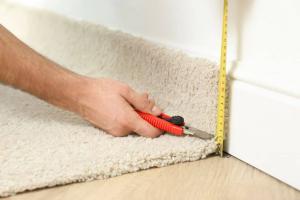Mastering Carpet Cutting: Your Ultimate Guide to Precision and Style

-
Quick Links:
- Introduction
- Tools Required for Cutting Carpet
- Preparation Steps Before Cutting
- Cutting Techniques Explained
- Common Issues and Troubleshooting
- Real-World Case Studies
- Expert Insights on Carpet Cutting
- Conclusion
- FAQs
Introduction
Cutting carpet can seem daunting, especially for those who have never attempted a DIY project before. However, with the right tools, techniques, and a bit of patience, you can achieve professional-level results. In this comprehensive guide, we will walk you through everything you need to know about cutting carpet, from the tools required to step-by-step instructions and troubleshooting tips.
Tools Required for Cutting Carpet
Before you embark on your carpet cutting journey, ensure you have the following tools at your disposal:
- Utility Knife: A sharp utility knife is essential for clean cuts.
- Carpet Cutter: Specialized tools for precise cutting.
- Measuring Tape: To measure the area accurately.
- Carpet Tacks or Staples: For securing the carpet edges.
- Straight Edge or Ruler: To guide your cuts.
- Chalk Line: For marking straight lines on the carpet.
- Gloves: To protect your hands while cutting.
Preparation Steps Before Cutting
Proper preparation is key to successful carpet cutting. Follow these steps:
- Measure the Area: Use your measuring tape to determine the dimensions of the space where the carpet will be installed.
- Purchase Extra Carpet: Always buy a little more carpet than you think you need to account for mistakes.
- Lay Out the Carpet: Unroll the carpet in the room where it will be installed, allowing it to relax for a few hours.
- Mark Your Cuts: Use a chalk line to mark where you need to cut; this ensures straight lines.
Cutting Techniques Explained
Below, we delve into various cutting techniques that will help you achieve the perfect cut:
1. Straight Cuts
For straight cuts, align your straight edge along the chalk line, and run your utility knife along the edge, applying steady pressure for a clean cut.
2. Curved Cuts
To make curved cuts, use a carpet cutter to gently guide the knife along the desired curve, taking your time to avoid jagged edges.
3. Notching
Notching is essential for corners. Use your utility knife to carefully notch out corners to ensure a snug fit against walls.
Common Issues and Troubleshooting
Even seasoned DIYers encounter issues while cutting carpet. Here are common problems and solutions:
- Uneven Cuts: If your cuts are uneven, double-check your measurements and ensure your straight edge is aligned properly.
- Fraying Edges: To avoid fraying, use a sharp knife and make sure to cut in one fluid motion.
- Incorrect Measurements: Always re-measure before cutting; it’s better to be safe than sorry.
Real-World Case Studies
Let’s explore some real-world examples of successful carpet cutting projects:
Case Study 1: Living Room Renovation
A homeowner decided to upgrade their living room carpet. By measuring carefully and using a chalk line, they managed to cut the carpet to fit perfectly around furniture without any visible seams.
Case Study 2: DIY Home Office
In creating a home office, another homeowner used leftover carpet from their living room. They used notching techniques to fit the carpet around built-in shelves, achieving a professional look.
Expert Insights on Carpet Cutting
We consulted with flooring experts to gather their best tips for cutting carpet:
- Plan Ahead: Always plan your cuts before you start to avoid mistakes.
- Practice Makes Perfect: If you're new, practice cutting on a scrap piece of carpet first.
- Invest in Quality Tools: A good-quality utility knife and straight edge can make a world of difference.
Conclusion
Cutting carpet doesn’t have to be a daunting task. With the right tools, techniques, and careful preparation, you can achieve beautiful results in your home. Remember to take your time, measure accurately, and practice when needed. Happy cutting!
FAQs
- 1. What is the best tool for cutting carpet?
- The best tool for cutting carpet is a sharp utility knife or a specialized carpet cutter.
- 2. How do I prevent fraying edges?
- To prevent fraying, ensure your knife is sharp and cut in a single, smooth motion.
- 3. Can I cut carpet without a straight edge?
- While it's possible, using a straight edge ensures cleaner, more accurate cuts.
- 4. Is it necessary to wear gloves?
- Wearing gloves is recommended for safety, as carpet cutting tools can be sharp.
- 5. How much extra carpet should I buy?
- Buy at least 10% more carpet than your measurements to account for mistakes and fitting.
- 6. What if I make a mistake while cutting?
- Don’t panic! You can often patch errors with leftover carpet or adjust your measurements.
- 7. How do I cut carpet around corners?
- Use notching techniques to carefully cut the carpet around corners for a snug fit.
- 8. Can I cut carpet with scissors?
- While possible, scissors are not recommended as they can produce uneven cuts.
- 9. What is the best way to dispose of carpet scraps?
- Check local regulations; many recycling centers accept carpet for proper disposal.
- 10. How can I ensure a professional look when cutting?
- Take your time, measure accurately, and use quality tools for the best results.
For further reading, consider visiting these authoritative sources:
- Home Depot - How to Install Carpet
- Flooring America - How to Cut Carpet
- Better Homes & Gardens - How to Install Carpet
Random Reads